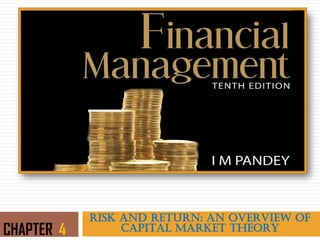
Risk and return - IMP.pdf
- 1. RISK AND RETURN: AN OVERVIEW OF CAPITAL MARKET THEORY CHAPTER 4
- 2. LEARNING OBJECTIVES Discuss the concepts of average and expected rates of return Define and measure risk for individual assets Show the steps in the calculation of standard deviation and variance of returns Explain the concept of normal distribution and the importance of standard deviation Compute historical average return of securities and market premium Determine the relationship between risk and return Highlight the difference between relevant and irrelevant risks 2
- 3. Return on a Single Asset Total return = Dividend + Capital gain 3 1 1 0 1 0 1 1 0 0 0 Rate of return Dividend yield Capital gain yield DIV DIV P P P P R P P P
- 4. Return on a Single Asset 4 Year-to-Year Total Returns on HUL Share
- 5. Average Rate of Return The average rate of return is the sum of the various one-period rates of return divided by the number of period. Formula for the average rate of return is as follows: 5 1 2 =1 1 1 = [ ] n n t t R R R R R n n
- 6. Risk of Rates of Return: Variance and Standard Deviation Formulae for calculating variance and standard deviation: 6 Standard deviation = Variance 2 2 1 1 1 n t t Variance R R n
- 7. 7 Investment Worth of Different Portfolios, 1980-81 to 2007–08
- 8. 8 HISTORICAL CAPITAL MARKET RETURNS Year-by- Year Returns in India: 1981-2008
- 9. Averages and Standard Deviations, 1980–81 to 2007–08 9 *Relative to 91-Days T-bills.
- 10. Historical Risk Premium The 28-year average return on the stock market is higher by about 15 per cent in comparison with the average return on 91- day T-bills. The 28-year average return on the stock market is higher by about 12 per cent in comparison with the average return on the long-term government bonds. This excess return is a compensation for the higher risk of the return on the stock market; it is commonly referred to as risk premium. 10
- 11. 11 The expected rate of return [E (R)] is the sum of the product of each outcome (return) and its associated probability: Expected Return : Incorporating Probabilities in Estimates Rates of Returns Under Various Economic Conditions Returns and Probabilities
- 12. Cont… The following formula can be used to calculate the variance of returns: 12 2 2 2 2 1 1 2 2 2 1 ... n n n i i i R E R P R E R P R E R P R E R P
- 13. Example 13
- 14. Expected Risk and Preference A risk-averse investor will choose among investments with the equal rates of return, the investment with lowest standard deviation and among investments with equal risk she would prefer the one with higher return. A risk-neutral investor does not consider risk, and would always prefer investments with higher returns. A risk-seeking investor likes investments with higher risk irrespective of the rates of return. In reality, most (if not all) investors are risk-averse. 14
- 16. Normal Distribution and Standard Deviation In explaining the risk-return relationship, we assume that returns are normally distributed. The spread of the normal distribution is characterized by the standard deviation. Normal distribution is a population-based, theoretical distribution. 16
- 18. Properties of a Normal Distribution The area under the curve sums to1. The curve reaches its maximum at the expected value (mean) of the distribution and one-half of the area lies on either side of the mean. Approximately 50 per cent of the area lies within ± 0.67 standard deviations of the expected value; about 68 per cent of the area lies within ± 1.0 standard deviations of the expected value; 95 per cent of the area lies within ± 1.96 standard deviation of the expected value and 99 per cent of the area lies within ± 3.0 standard deviations of the expected value. 18
- 19. Probability of Expected Returns 19
- 20. Example An asset has an expected return of 29.32 per cent and the standard deviation of the possible returns is 13.52 per cent. To find the probability that the return of the asset will be zero or less, we can divide the difference between zero and the expected value of the return by standard deviation of possible net present value as follows: The probability of being less than 2.17 standard deviations from the expected value, according to the normal probability distribution table is 0.015. This means that there is 0.015 or 1.5% probability that the return of the asset will be zero or less. 20